|

HyperScale is proudly supported by Squadron
The Merlin’s roar reverberated
throughout the valley as the Spitfire raced for home. Flying Officer Al Harley
looked down briefly upon the scene below. A stricken “bird” was lying broken and
forlorn, the remains of it’s last target, a flak emplacement, smouldered nearby.
As Harley flashed past, he noticed
the grey-clad soldiers running towards the now silent Spitfire Mk Vb. Even with
the blur of speed, he could clearly see the codes on the fighter’s fuselage,
“RS-T.” His element leader, the commander of the crack Biggin Hill Wing was
down, finally vanquished after three years of war.
It was January 28, 1942 and the
pilot of the downed aircraft was an RAF legend. Wing Commander Roland Robert
Stanford Tuck, attempted to shield the twenty-nine swastikas painted on his
Spitfire from the menacing gaze of the rapidly advancing German troops. Those
little white, crooked crosses, insignificant as a single entity, each marked a
victory over an enemy pilot in his machine. Combined, they were mute testimony
to hundreds of hours scanning the heavens with tired, streaming eyes and
savagely fighting for the life of the individual in the cockpit and for the
nation that refused to yield to the overtures of a tyrant.
|
Roland Robert Stanford Tuck's Aircraft
Galleries |
Tamiya 1/48 Spitfire Mk Ia
No 65 (East India) Squadron
Motto: “By Force Of Arms”
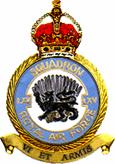 On
completion of pilot’s course, Pilot Officer Robert Stanford Tuck was posted to
65(F) Squadron to fly Gloster Gauntlets and Gladiators. He was promoted to
Flying Officer during 1938 and was selected to represent 65SQN on the Spitfire
conversion course to be held at Duxford. The first Mk Ia that he flew was K9796
and it is safe to say, that it made a lasting impression on the young aviator.
He returned to 65SQN on January 9th 1939, as one of the RAF’s first
qualified Spitfire pilots. Following the outbreak of the second world war, he
was made a flight commander in that unit. On
completion of pilot’s course, Pilot Officer Robert Stanford Tuck was posted to
65(F) Squadron to fly Gloster Gauntlets and Gladiators. He was promoted to
Flying Officer during 1938 and was selected to represent 65SQN on the Spitfire
conversion course to be held at Duxford. The first Mk Ia that he flew was K9796
and it is safe to say, that it made a lasting impression on the young aviator.
He returned to 65SQN on January 9th 1939, as one of the RAF’s first
qualified Spitfire pilots. Following the outbreak of the second world war, he
was made a flight commander in that unit.
The Model
Click here to see a Gallery
of additional images
The first Spitfire is marked as FZ o L, K9906
during May 1939; this was one of the earliest squadron-assigned Spitfires flown
by RST. It is in the standard pre-war colour scheme of Dark Earth and Dark Green
in the “A” pattern camouflage, with painted Aluminium lower surfaces. I used
Gunze paints for the upper surfaces, with Testor's Aluminium non-buffing
metaliser for the lower surfaces.
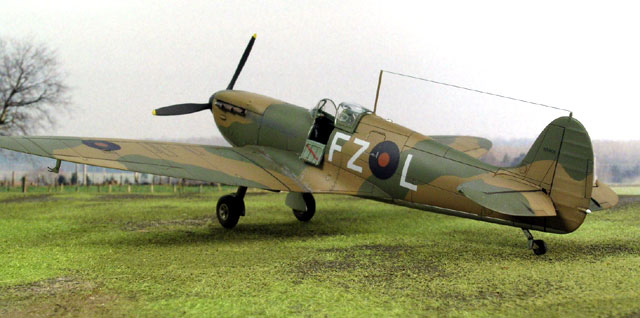
The basic kit was modified to represent the
early Mk Ia configuration as follows:
·
Unarmoured windscreen and
flat-sided pressure-vent equipped hood. (Falcon Clear Vac set 51 – Spitfire
Special)
·
Pole type antenna mast
made from brass tubing.
·
Addition of a ring sight
from Eduard.
·
Modification of the pitot
tube to the early twin-probe type.
·
Chassis retraction
selector box replaced with hydraulic hand pump and selector lever.
·
Deletion of the voltage
regulator.
·
Replacement of the poorly
represented kit seat with the Cutting Edge Spitfire seat with early “Sutton”
harness. (CEC48347)
·
The exhausts were
replaced with items from Ultracast (48040)
·
Decals are from the
Victory Productions, Spitfire – Aces of the Empire set (VPD48006)
An excellent photo of this aircraft appears on
Page 38 in “Combat Legend. Spitfire Mks I – V” by Peter Caygill (2002, Airlife
Publishing Ltd). This clearly shows pertinent modification details and depicts
the aircraft with the serial repainted in miniature on the fin.
Tamiya 1/48 Spitfire Mk Ia
No 92 (East India) Squadron
Motto: “Either Fight Or Die”
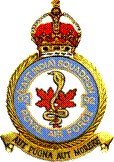 On
May the 1st 1940, RST was posted to No 92 Squadron under the command
of Squadron Leader Roger Bushel. This gallant officer was to become legendry as
“Big X” at Stalag Luft III and led the famous escape. He was one of sixty
executed by the Gestapo upon their recapture. Tuck was promoted to the rank of
Flight Lieutenant and appointed as a flight Commander by Bushell. On
May the 1st 1940, RST was posted to No 92 Squadron under the command
of Squadron Leader Roger Bushel. This gallant officer was to become legendry as
“Big X” at Stalag Luft III and led the famous escape. He was one of sixty
executed by the Gestapo upon their recapture. Tuck was promoted to the rank of
Flight Lieutenant and appointed as a flight Commander by Bushell.
During the frenetic activity of the Dunkirk
evacuation, RST gained the first of his aerial victories, a Messerschmitt
Bf-109, on the morning of May 23rd and added two Bf-110s during the
afternoon. However, his final victim of the day had also scored, with Tuck being
forced to “dead stick” his battle-damaged Spitfire on to the grass verge in
front of the Hornchurch control tower.
The elation from his victories was
short-lived, with the news that the squadron had suffered heavily, almost half
it’s strength had gone, including the Commanding Officer. Group Captain “Daddy”
Bouchier made the decision to give Tuck the squadron. Under RST’s leadership,
gone were the out-dated Fighter Area Attacks and tight, three-ship “vic”
formations became a thing of the past.
His personal score began to mount over the
coming days. His bravery and skill was recognised, with the award of the
Distinguished Flying Cross on June 11th. His Majesty King George VI
presented his award at a ceremony at Hornchurch, on June the 28th. It
was to be the first of many meetings with royalty.
The Model
Click here to see a Gallery
of additional images
The next Spitfire is marked as GR o P, N3249
during May 1940. This aircraft is believed to be the Spitfire flown on May 23rd,
when RST gained his initial victories. It is depicted in the standard “B”
pattern camouflage scheme of Dark Earth and Dark Green. However, as an
additional recognition feature adopted in late 1939, the undersides of the
aircraft were divided evenly along the fuselage centreline, with the port side
being painted in Night and the starboard in white. Polly Scale Dark Earth and
Dark Green were used, along with Tamiya Flat White. The “Night” was mixed from
Tamiya Dark Red and Flat Black, after reading Brett Green’s excellent Tamiya
Spitfire Ia review on HyperScale.

The superb Tamiya kit received the following
minor additions:
·
Once again, the kit seat
was replaced with the Cutting Edge Spitfire seat. This time without the moulded
harness. (CEC48349)
·
An Eduard “Sutton”
harness was added. As was Eduard PE armour plate to the rear of the seat. (More
on this to follow)
·
The exhausts were
replaced with items from Ultracast.
·
Decals were again from
the outstanding Victory Productions set.
Following completion of this model, (isn’t it
always the way?), I purchased the excellent “Spitfire – A Complete Fighting
History” by Alfred Price, (1991, Promotional Reprint Company). This is a
combination of his “Spitfire At War” and “Spitfire At War 2.”
They say that 20/20 hindsight and zero groundspeed is a
beautiful thing. I would agree. Using this reference, I believe there is
sufficient evidence to question this scheme, for the timeframe involved. Pg 29
shows a photo of RST, with P/Os Holland and Wright, standing in front of
Spitfire GR o U. It has the Night port wing, starboard wing (probably) in white,
with the remainder of the fuselage underside appearing to be a vastly different
shade. Initially, I had suggested Duck Egg Green for this area, which was
incorrect. Through the wonders of international e-mail, a couple of very kind
readers informed me that the colour should be painted Aluminium, as DEG (Sky)
was not introduced until later in the year.
As to the armour plate, I added the armoured
glass windscreen, as well as the seat-back armour. On re-reading “Fly For Your
Life” by Larry Forrester (again, after model completion), Tuck states that the
armoured windscreen was only fitted just prior to the afternoon sorties on the
23rd of May and, was the only armour the aircraft had at that stage.
Cest la guerre. Anyway, I am happy with the final result and the scheme is
pleasing to the eye.
Hasegawa 1/48
Hurricane Mk Is
and
Revell Hurricane Mk IIc
No 257 (Burma) Squadron
Motto: “Death Or Glory”
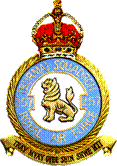 During
the height of the Battle of Britain on the 11th of September, RST was
posted to command No. 257 Squadron, which was based at Debden. Jeff Myers, the
unit adjutant, summed-up his new leader; “he had a brilliant flying record – 14
kills (but probably 17 or 18 was nearer the truth) a series of fantastic
escapes, his legend was growing.” During
the height of the Battle of Britain on the 11th of September, RST was
posted to command No. 257 Squadron, which was based at Debden. Jeff Myers, the
unit adjutant, summed-up his new leader; “he had a brilliant flying record – 14
kills (but probably 17 or 18 was nearer the truth) a series of fantastic
escapes, his legend was growing.”
On the 15th of the month, in his first sortie leading
the squadron, he shot down a Bf-110 and claimed a Bf-109 as a probable. During
September and October, he continued to score freely as the Battle of Britain
drew to a close. He was awarded a well-deserved bar to his DFC on the 25th
of October. More victories during December capped-off a successful year, with
his personal tally standing at 18 confirmed.
The new year of 1941 was celebrated in style, with the news that
he had been awarded the Distinguished Service Order for his outstanding
leadership and personal courage. Once again, His Majesty presented the coveted
award, along with the previously gazetted bar to the DFC. By coincidence,
exactly one year later at that very hour, he was shot down in France.
Victories were gained by day and night, as the reputation of 257
Squadron, and its celebrated leader grew. A second bar was awarded to his DFC.
Tuck becoming the second RAF officer to achieve this feat. During April, the
squadron re-equipped with the cannon armed Mk IIc Hurricane. Tuck had always
been a vocal critic of the Browning .303 machine gun and welcomed the chance to
use four 20mm cannon against his foe.
On June 21st
1941, RST was flying Z3152 when he became involved in a pitched battle with
Bf-109s. He managed to shoot down two of his attackers and damage another,
before he himself was shot down into the English Channel. Following more than
two hours adrift in his dinghy, he was picked up by a coal barge and returned to
Gravesend, cold, wet and with 28 victories now to his credit.
The Models
Click here to see a Gallery
of additional images
Firstly, there is Hurricane Mk Ia, DT o A -
V6555. This was the first Hurricane assigned to RST when he took command of 257
Squadron. It had a small caricature of Churchill on the port side below the
cockpit and, was the first to display victory markings.
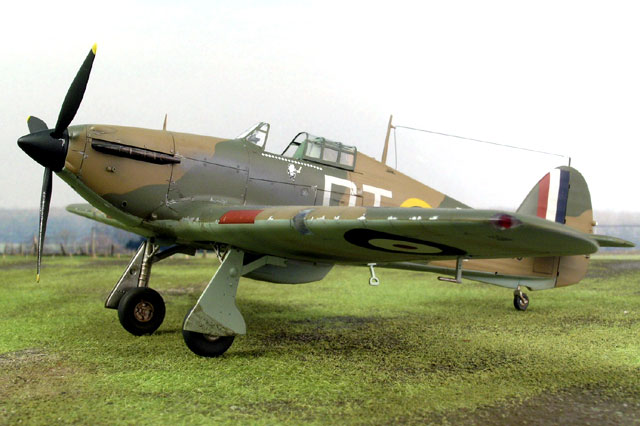
The magnificent Hasegawa Mk I “Douglas Bader”
edition Hurricane was the basis, with only a few minor modifications. It is
painted with Gunze Sangyo Dark Earth and Dark Green in the “A” pattern, over
Testors Acryl Sky
-
Ultracast supplied the seat and back armour
(48019).
-
The exhausts were replaced with items from
Ultracast (48043)
-
Decals came from the Aeromaster Battle of
Britain Special Set and were sent to me by Scott Taylor of Canada.
-
Master modeller Tom Cleaver supplied the
early DeHavilland propeller and spinner.
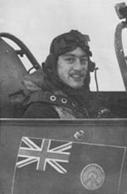 Secondly,
there is RST’s most famous Hurricane Mk Ia, DT o A - V6864 (in which the
photograph to the left is taken). Tuck flew this aircraft as his regular mount
from December 1940 through to April 1941, following a sortie where V6555
suffered an extreme case of German-induced lead poisoning! Secondly,
there is RST’s most famous Hurricane Mk Ia, DT o A - V6864 (in which the
photograph to the left is taken). Tuck flew this aircraft as his regular mount
from December 1940 through to April 1941, following a sortie where V6555
suffered an extreme case of German-induced lead poisoning!
Once again, Hasegawa supplied the basic kit.
In this case, it was the Mk Ia “Squadron Leader” special, which came with
markings for V6864. Gunze paints were sprayed in the “B” scheme on the upper
surfaces. The repainting in Night of the underside of the port wing was
reintroduced in late 1940 early ’41. The undersurfaces were painted with Tamiya
Sky and the Night mixture. At this stage, it was also directed that a sky band
be applied to the empennage. This was duly applied using Testors Sky to give the
slight contrast that was apparent in photos of V6864. There is also much
conjecture as to the colour of the Rotol spinner on this aircraft. After
examining many photos, I decided to use white rather than sky, along with the
red.
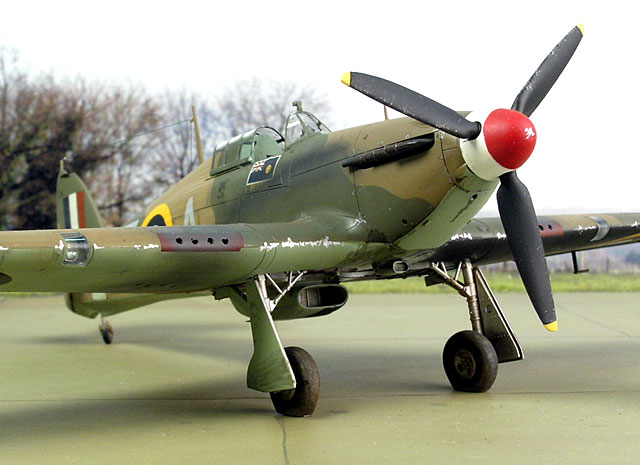
This time, I decided to add a little more to
the basic kit:
-
I used the Eduard PE Zoom set (FE108) for
extra cockpit details…looking back, this was a waste of time as the Hasegawa
base product is excellent.
-
Ultracast again supplied the replacement
exhausts.
-
Ultracast Hurricane resin control surfaces
(48042) were added to “animate” the airframe. I ensured that the control
column was modified to display the correct control displacement.
-
Resin wheels (48076) and wheel well insert
(48079) were added from you know who. (I think that I’ve established a college
fund for their children!)
-
Decals came from the kit (that was easy,
wasn’t it?)
The final Hurricane is
the Mk IIc, FM o A – Z3152. During 1941, 257SQN codes were changed from the
well-known DT. It is thought that only one photo is available of this aircraft.
Unfortunately, I did not receive permission to include it in this article.
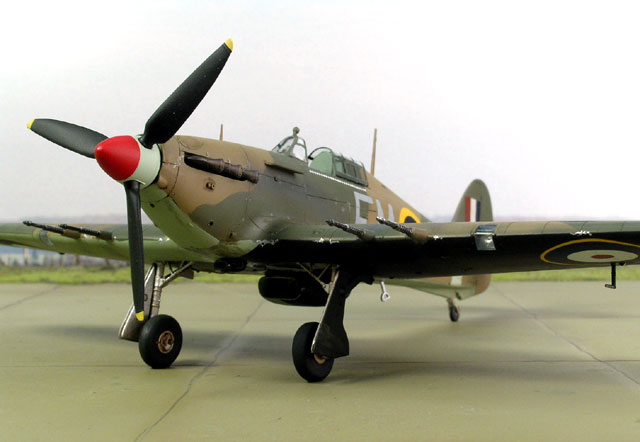
The Revell boxing of the Hasegawa Mk IIc was
used.
-
The armour plate and seat were replaced, as
per V6555.
-
Ultracast Mk II “fishtail” exhausts (48044)
were used.
-
Decals were a mix-n-match from various
manufacturers and were donated by a number of very-kind readers of Hyperscale.
In addition, I used codes and serials from the Tally Ho Decal sheets.
Tamiya 1/48 Spitfire Mk Vb
Biggin Hill Wing Leader
In mid July of 1941, just a few days past his
twenty-fifth birthday, Tuck was given command of the Duxford Wing comprising Nos
601, 56 and 12 Squadrons. An eclectic mix of aircraft was available for the new
wing leader to fly. 601 were in the process of re-equipping with the American
Airacobra, 56 were converting to the Typhoon and 12, better known as the Third
Eagle Squadron, was happy with their Spitfire Mk Vbs. During his brief tenure at
Duxford, a Bf-109 fell to the guns of his Spitfire – 29 down. He was believed to
be the RAF’s highest scorer at that time.
As the old saying goes, “all good things must
come to an end” and the AOC of No 12 Group, Air Vice-Marshal Saul, informed him
that he was being taken off operations. Despite many protestations, the edict
stood. However, the good news was that he was to head to the then neutral,
United States of America on a lecture tour. Among the party were Tuck’s old
friend “Sailor” Malan and that gallant Australian, Wing Commander Hughie Edwards
VC.
Following an enjoyable sojourn overseas, RST
took command of the celebrated Biggin Hill Wing on December 1st,
1941. Again, Wing Commander Tuck elected to fly his favourite mount – the
Spitfire Mk Vb.
The Model
Click here to see a Gallery
of additional images
This Mk V depicts BL336 on the morning of 28
January 1942. It was in this aircraft that Tuck was shot down by ground fire
during a low-level “Rhubarb” mission. It is coded with Tuck’s initials, RS o T,
which was an honour accorded to Wing Commanders and above. It also displays his
final tally of 29 victories on the fuel tank cover.

Tamiya’s Spitfire Mk Vb was the obvious choice
for me, as it was on special for AUS$15 in a local store. The kit was “shake and
bake” personified, and was a joy from start to finish. Just the thing after a
hard day “flying a desk” at work. In late 1941, the Air Ministry directed that
fighter aircraft would be painted in a new scheme of Ocean Grey and Dark Green
over Sea Grey Medium. The Sky fuselage band and spinner were to be retained,
along with the addition of yellow along the wing leading edge to aid
recognition.
Some aircraft were repainted as they moved
through repair depots or in the field. A shortage of the new colours meant that
some colours had to be mixed from available stocks. BL336 was an example of the
repainting program. I used Polly Scale paints for all colours, mixing the
“hybrid” Ocean Grey from Sea Grey Medium and Night on the advice of Bob
Swaddling. The “A” scheme became standard in 1941 and the aircraft was repainted
with hard-edged colour demarcations. This is clear in many photos of BL336
following its crash landing.
The kit was built with only a couple of very
minor additions.
-
Cutting Edge supplied the seat (CEC48347).
-
The exhausts were replaced with resin items
from Ultracast (48041)
-
Decals came from the Victory Productions
sheet. (Only 37 more schemes to use!!!!!!)
Following the abrupt end to his wartime flying career, he was
captured and imprisoned in Stalag Luft III for three years, where he was a
leading member of the “X” Organisation. Transferred just prior to “the Great
Escape,” he managed to break from custody in January 1945. Partnering a Polish
RAF pilot he made his way to freedom via Poland, to meet up with the advancing
Russian army. He fought alongside the troops as an infantry officer, before
finding his way to the British Embassy in Moscow. He finally returned to England
in April 1945.
His victory tally at war’s end was 29 aircraft destroyed, 8
probables and 6 damaged.
Following refresher training on Harvards, WGCDR Stanford Tuck
flew Vampires and Meteors at Tangmere and West Raynham. He received his final
decoration, the United States DFC, on 14 June 1946. Posted as Station Commander
of RAF Coltishall, then to Singapore, he retired from the RAF in 1949, becoming
a successful mushroom farmer and businessman.
He passed away in 1987 at the age of 70.
Postscript:
In 1982, the wreckage of a Bf-109 from the “Richtofen”
Jagdgeschwader was unearthed in a farmer’s paddock by an investigation team.
Following exhaustive research by the Ministry of Defence, it was assessed that
this aircraft was one that had been previously claimed by Tuck as a “probable.”
WGCDR Stanford Tuck’s official score has now been amended to
thirty confirmed victories.

Having been out of the hobby for a
considerable time, I was delighted to rekindle my love of modelling with this
project. Bob Stanford Tuck has always been a hero of mine and I was delighted to
finally add his aircraft to my collection.
This project would not have come to
fruition, had it not been for the invaluable assistance of fellow modellers. In
no particular order, I would like to thank the following for their patience,
humour, decal-donations and extraordinary depth of knowledge:
Tom
Cleaver Bob Swaddling
Paul Cotcher
Scott Taylor
Daryl Huhtala
Douglas Blake
Adam
Lewis
Peter, for his approval to use
items from his excellent website;
www.stanfordtuck.com and
of course, Brett Green - for making my models look much better than they really
are!
Text Copyright © 2003 by
SQNLDR David Turner
Model Images Copyright © 2003 by
Brett Green
Page Created 14 September, 2003
Last Updated
19 April, 2004
|
Home |
What's New |
Features |
Gallery |
Reviews |
Reference |
Forum |
Search